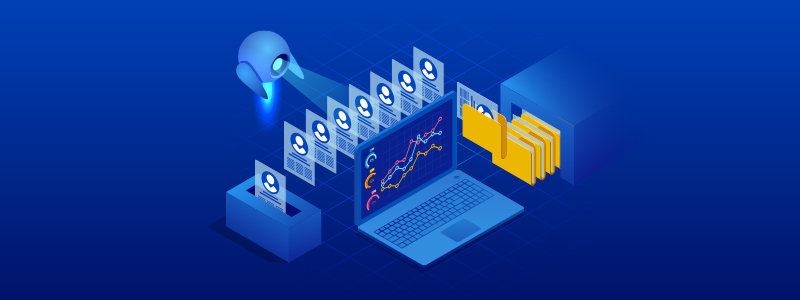
What is Process Orchestration? A Complete Guide
What is Process Orchestration?
Process orchestration, also called business process orchestration, is a highly coordinated approach to managing and organizing multiple automated tasks or workflows to achieve desired business outcomes. Process orchestration goes beyond automating individual tasks as it provides a holistic view of the entire process, allowing organizations to identify bottlenecks, improve decision-making, and enhance overall performance. Orchestrating complex business processes enables organizations to streamline operations, reduce errors, and deliver better customer experiences.
An example of process orchestration would be an end-to-end data integration process comprising ETL, data quality checks, data governance, and integration with downstream systems. In this case, process orchestration establishes clear pathways for data and tasks to flow seamlessly between these components (systems, applications) through integration platforms and middleware.
Importance of Process Orchestration
Through process orchestration, organizations can standardize their processes from end-to-end, increase resiliency, and reduce complexity in executing tasks. This process involves multiple tasks like:
Workflow Automation
Process orchestration includes workflow automation, which means it automates individual tasks and more extensively coordinates the sequences of these tasks. Workflow automation enhances efficiency and reduces errors by automating repetitive actions, such as data entry, approvals, and notifications.
Integration
Effective process orchestration relies on flawless integration between systems and applications to ensure uninterrupted data flow. Connecting disparate systems eliminates manual data transfer, improves data consistency, and enhances overall process speed.
Collaboration
Process orchestration helps teams collaborate better by creating a clear path for tasks and information to flow between teams and departments. It ensures that everyone involved in a process has the necessary information and can contribute and cooperate effectively.
To achieve this, businesses can benefit significantly from deploying robust internal communication strategies. By utilizing such strategies, good internal communication enables teams to share insights and information seamlessly, contributing to improved process efficiency and collaboration. Knowing which tools can help with good internal communication is vital for any organization seeking to enhance these areas.
Visibility and Control
With process orchestration, organizations gain real-time visibility into process execution by tracking task progress, identifying bottlenecks, and measuring performance metrics, such as task completion time, error rate, and resource utilization. This visibility into process execution allows monitoring, analysis, and optimization. Bottlenecks can be identified and fixed quickly, ensuring the process operates efficiently.
Process Orchestration vs. Process Automation vs. Other Automation Methods
One of the most common alternatives to process orchestration is task-based automation, which utilizes custom scripts or robotic process automation (RPA) software. However, this method is only effective when the user interfaces of applications and the nature of tasks don’t change often. Automating the tasks enhances a process’s efficiency without solving its inherent issues.

For instance, automating data entry into a static form using RPA can improve efficiency, but it won’t address underlying process inefficiencies like redundant data sources or manual approvals.
Business process automation (BPA) is another strategy enabling event-based automation. This approach triggers actions based on a specific event or occurrence within the system. The drawback is that its setup and maintenance are challenging and demand specific technical knowledge.
In contrast, process orchestration overcomes these limitations. It allows for the creation of end-to-end automated workflows to maintain automation. Process orchestration accelerates automation deployment and scaling by providing a centralized hub for designing, managing, and executing complex workflows. It also enables more intelligent automation by allowing one process to trigger another.
Types of Process Orchestration
Data Orchestration
Data orchestration is the automated management and coordination of data movement across various systems and processes. It involves scheduling, executing, and monitoring data pipelines to ensure accurate, timely, and reliable data flow. Orchestrating data accelerates data processing, minimizes human error, and empowers organizations to derive actionable insights faster.
Application Orchestration
Application orchestration is the automated coordination and management of multiple applications, services, and infrastructure components, like storage and databases. It defines the sequence of interactions between these applications and handles the data exchange.
Service Orchestration
By orchestrating various IT components and processes, service orchestration automates coordinating and managing IT services and resources, such as designing, creating, and delivering services. Service orchestration is important in telecom and IT services, promoting the smooth operation of interconnected services and minimizing manual intervention.
Cloud Orchestration
It is the automated management and provisioning of cloud computing resources. Cloud orchestration involves allocating and configuring resources such as virtual machines, storage, networks, and databases in response to application demands. It automatically adjusts the cloud resources based on workload fluctuations by monitoring system performance metrics, applying predefined scaling policies, and dynamically adding or removing resources to maintain optimal performance and cost efficiency.
Security Orchestration
Integrating and orchestrating security technologies, such as firewalls, intrusion detection systems, and endpoint protection platforms, creates a unified and responsive security framework. Security orchestration improves threat detection, incident response, and overall security efficiency by automating security operations,
Customer Journey Orchestration
Customer journey orchestration strategically manages customer interactions across multiple touchpoints, like mobile apps, websites, social media, and physical stores. Understanding customer behavior and preferences leads to delivering tailored experiences that drive engagement, loyalty, and revenue.
Who Uses Process Orchestration?
Process orchestration is gaining traction across various sectors, including finance, healthcare, and manufacturing. These industries leverage process orchestration to automate and streamline operations like order-to-cash and procure-to-pay.
- Developers use process orchestration to deploy new features, manage operational systems, and integrate functionalities. They automate code integration, testing, and version control for software development and deployment pipelines.
- IT operations teams monitor and maintain workflows to increase optimal system performance. They automate routine maintenance tasks, manage system configurations, and orchestrate infrastructural changes to enhance operational efficiency and reliability.
- Data engineering/science teams or BI experts use process orchestration to design, automate, and maintain data pipelines. Depending on their roles and the industry/department they work in, they use these pipelines for various purposes.
- HR departments streamline employee onboarding and offboarding processes using process orchestration. They manage applications for leave and benefits, automate training programs, and establish pathways for professional development. Internal communication processes, such as performance reviews, are also automated to improve efficiency.
- Compliance teams automate compliance checks and ensure adherence to regulatory standards using process orchestration. They orchestrate risk management procedures and monitor changes in legislation to adjust organizational processes.
- Sales and marketing departments automate lead qualification and distribution processes through process orchestration. They orchestrate multi-channel marketing campaigns, manage customer segmentation, and personalize marketing efforts. The orchestration streamlines the entire sales process from lead generation to conversion, enhancing overall sales efficiency.
Significant Issues that Process Orchestration Addresses
Process orchestration helps in optimizing business efficiency and productivity. By effectively managing and coordinating complex processes, it addresses the following key challenges:
Resource Shortage and Management
Process orchestration optimizes resource utilization by automating routine tasks and reducing manual intervention. It facilitates the identification and allocation of resources based on real-time demand. Organizations can adjust resource allocation by monitoring workload and resource availability. This approach to resource management enhances overall operational efficiency and responsiveness.
Managing Multiple Endpoints
Businesses are now operating with the help of complex, interconnected systems and applications. Process orchestration manages interactions between multiple endpoints, ensuring seamless data flow and communication. Organizations can avoid data inconsistencies and improve overall process efficiency by establishing clear connections and dependencies between systems.
Minimizing Manual Errors
Process orchestration reduces the risk of human error by automating recurring tasks and removing manual data entry. Organizations can attain higher accuracy and reliability in their operations by standardizing processes and enforcing business rules.
Lack of Visibility and Control
Organizations struggle to identify bottlenecks, measure performance, and make decisions without a clear overview of processes. Process orchestration provides real-time visibility into process execution, allowing for effective monitoring, analysis, and optimization.
Benefits of Process Orchestration

Orchestration brings several advantages to organizations across various aspects of operations and management.
Return on Investment (ROI)
Process orchestration helps deliver a return on investment by automating repetitive tasks and optimizing processes. It reduces operational costs and minimizes errors, improving efficiency and effectiveness.
Actionable Insights
It helps teams develop actionable insights by tracking and analyzing workflows. Process orchestration also facilitates the identification of productivity disparities among teams and pinpoints bottlenecks. It enables adjustments to workflows and resource allocations for continuous improvement.
Reliability
As applications within organizations evolve, the established connections and automation maintain their reliability. Process orchestration supports leveraging the applications’ APIs rather than their user interfaces. Also, if any part of a business process requires modification over time, the process orchestration platform enables professionals to implement the necessary adjustments efficiently. This capability underscores the platform’s adaptability and efficiency.
Customer Success
Process orchestration helps teams accomplish the timely completion of tasks and projects, reducing the likelihood of missed Service Level Agreements (SLAs). This reliability enhances client satisfaction due to improved service delivery and responsiveness.
Employee Satisfaction
Automating repetitive tasks through a process orchestration approach enables employees to focus on more value-added work. This shift increases productivity and enhances job satisfaction by empowering employees to contribute meaningfully to strategic initiatives and innovation within the organization.
How To Select the Right Process Orchestration Platform
Multiple tools are available in the market for end-to-end workflow automation and orchestration. Still, organizations should keep certain aspects in mind while choosing such tools.
REST API Adapters
Process orchestration tools with REST API adapters can utilize APIs by transforming API methods into reusable, automated tasks. This capability is critical for building complex and interconnected processes. By integrating with various systems through their APIs, process orchestration tools can create seamless workflows, automate data exchange, and optimize business operations.
For example, a process orchestration tool can utilize a CRM system’s API to retrieve customer information, trigger an email marketing campaign through another API, and update customer records based on campaign responses. The entire process can be carried out with minimal user intervention.
Real-time Monitoring Capabilities
Process orchestration tools equipped with monitoring capabilities provide auto-remediation, where the system can automatically address minor issues without human intervention. This approach reduces troubleshooting time, improves process efficiency, and enhances system reliability.
Self-Service Portals
Process orchestration aims to centralize and streamline automation across IT, business processes, and help desks. Self-service portals empower non-IT users to manage automated tasks via an intuitive interface, such as starting, stopping, and restarting processes. This approach decreases the volume of IT support requests and frees up more time for development tasks.
Low-Code Development
Organizations should opt for a process orchestration tool with DevOps tools, including dependency mapping, process modeling, and collaboration features.
Another essential feature is low-code/no-code development, typically facilitated by a drag-and-drop workflow designer. This no-code feature minimizes the complexity of the underlying code, allowing developers to create end-to-end processes with minimal coding expertise.
Conclusion
The main advantage of process orchestration is that it minimizes human intervention in a complex and interconnected system, reducing the chance of errors. As businesses continuously strive to streamline their processes, it is time to invest in process orchestration tools and gain a competitive edge.
Astera is a complete data management platform that allows organizations to design, automate, and orchestrate complex data integration, management, and warehousing processes. It offers connectors for various file sources, database providers, applications, and APIs. With its no-code interface, Astera allows users to manage their data and automate data-related processes with minimal IT intervention.
Schedule a demo today to experience how Astera orchestrates the workflows and monitors the entire business process.
Ready to Simplify Your Process Orchestration?
Discover how Astera can simplify your data management and orchestrate your workflows with ease. Schedule a demo today to see how our no-code platform can make managing your business processes straightforward and efficient.
Request a Demo Astera AI Agent Builder - First Look Coming Soon!
Astera AI Agent Builder - First Look Coming Soon!


